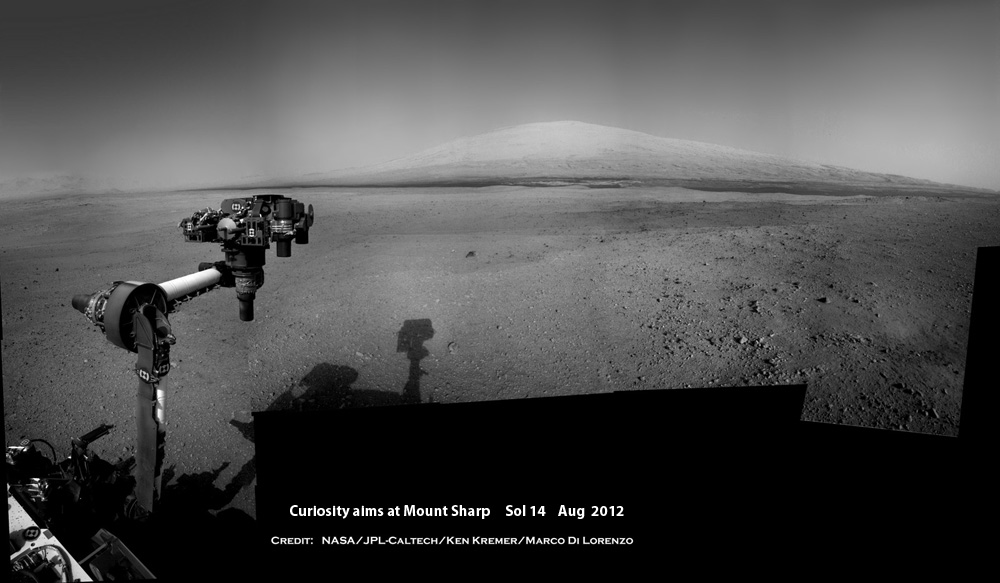
Virtually since the moment of the nail-biting touchdown of NASA’s Curiosity mega rover inside Gale some 2.5 years ago, the most powerful camera orbiting Mars has been keeping tabs on the blast zones and scars created by the impact of the rover and other components of the landing gear.
The High Resolution Imaging Science Experiment (HiRISE) camera on NASA’s Mars Reconnaissance Orbiter soaring overhead has periodically observed the rover as well as the heat shield, descent stage, back shell, and parachutes to track changes over time from the August 2012 landing, until as recently as February 2015. And future observations will undoubtedly continue.
Scientists used HiRISE for detailed observations looking at the dark blast zone exposures resulting from the impacts that hurled way the omnipresent bright surface dust and how they faded over time. In some cases the areas actually darkened again.
“After fading for about two years, the pace of change slowed and some of the scars may have even darkened again,” says NASA.
The lead sequence of seven repeating images, a GIF animation, shows the scar created by the descent stage smashing into the ground. See below.

Recall that the “sky crane” descent stage hovered over Curiosity as it was lowered by tethers onto the Red Planet terrain. After pyros severed all the cords, the descent stage flew approximately 2,100 feet (650 meters) away to prevent local contamination and impacted the ground with a mighty force.
Somewhat surprisingly, the most recent image, taken in February 2015, shows that “this blast zone is not fading as quickly as expected, and may even be darkening. This indicates that understanding is still incomplete about processes that move dust around on the Martian surface.”
HiRISE was targeted to capture blast zone images at four different locations showing changes created by NASA’s Curiosity Mars Science Laboratory (MSL) rover and several critical pieces of the never-before-used landing hardware.

“Spacecraft like Curiosity create these dark blast zone patterns where bright dust is blown away by the landing,” said Ingrid Daubar, a HiRISE team scientist at NASA’s Jet Propulsion Laboratory, Pasadena, Calif., who has used similar blast zones to find fresh meteor impact sites on Mars.
“We expected to see them fade as the wind moved the dust around during the months and years after landing, but we’ve been surprised to see that the rate of change doesn’t appear to be consistent.”
The team created a series of four GIF animations (compiled here) by combining images gathered over five to seven different dates from the different hardware locations since the unprecedented sky crane landing maneuver some 31 months ago. In each sequence, the first image is from a HiRISE observation taken on Aug. 12, 2012, six days after Curiosity’s daring landing.
In another GIF animation, the car-sized rover itself and its pair of wheel tracks are imaged at the Bradbury landing site in exquisite detail. The robot is seen to quickly scurry off and disappear once it set sail on her epic expedition across the crater floor, a few weeks after safely landing. The wheel tracks are also seen to fade over time.

The touchdown zone is named in honor of renowned science fiction writer Ray Bradbury, author of “The Martian Chronicles” and numerous other books and short stories.
The HiRISE camera is one of six instruments aboard MRO and captured the high resolution images that were a key factor in selecting Gale Crater as the landing site.
The interior of the crater is overwhelmed by humongous Mount Sharp.
Scientists have also used HiRISE to periodically image Curiosity during its overland traverse across the crater floor and to chart the safest and most scientifically productive spots for up-close scrutiny and, in some case, drilling and sampling for chemical analysis by the pair of on board miniaturized chemistry labs: SAM and CheMin.

Credit: NASA/JPL-Caltech/Univ. of Arizona
The main goal here of periodic follow-up imaging “has been to check whether scientists could model the fading and predict how long it would take for the scars to disappear,” says NASA.
Of course, there were surprises since it’s a modeling exercise designed to learn and test theories.
There are also practical benefits deriving from Daubers work in readying NASA’s next Mars lander, InSight, due to blastoff on March 4, 2016. Read the new article about assembly operations here.
“The InSight mission will deploy a heat probe that will hammer itself a few yards, or meters, deep into the ground to monitor heat coming from the interior of the planet. The brightness of the ground affects temperature below ground, because a dark surface warms in sunshine more than a bright one does.”

Credit: NASA/JPL-Caltech/Univ. of Arizona
See still image below
In late-March, Curiosity discovered a beautiful patch of vein filled rocks on her epic trek up from the foothills of Mount Sharp—detailed here.
Mount Sharp is comprised of sedimentary rock layers that record the history of ancient Martian environments and is the primary destination of the mission.
The mountain towers 3.4 miles (5.5 kilometers) into the Martian sky and dominates the center of the Gale Crater landing site, where Curiosity safely touched down on Aug. 5, 2012.
As of today, Curiosity’s odometer totals over 6.4 miles (10.3 kilometers) since landing inside Gale Crater on Mars in August 2012. She has taken some 224,815 images during over 940 Sols of exploration.

Meanwhile, older sister rover Opportunity ascended to the summit of Cape Tribulation along Endeavour crater on the opposite side of Mars and has arrived at Marathon Valley loaded with Martian minerals treasures formed in ancient flowing neutral water, more conducive to the formation of microbial life forms. On Jan. 24, she also celebrated her astonishing 11th anniversary roving the Red Planet!
Stay tuned here for continuing updates from Mars and throughout our Solar System!
Want to keep up-to-date with all things space? Be sure to “Like” AmericaSpace on Facebook and follow us on Twitter: @AmericaSpace






There are not enough superlatives to describe Curiosity’s mission.